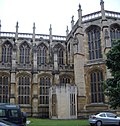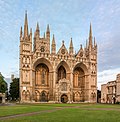Monarchs of England (to 1603)
Pre-conquest
| Name | Death | Place of burial | Image |
|---|---|---|---|
| Egbert | 839 | Old Minster, Winchester Bones now thought to be in one of the six mortuary caskets in Winchester Cathedral |  |
| Æthelwulf | 855 | Steyning Church, then the Old Minster, Winchester Bones now thought to be in one of the six mortuary caskets in Winchester Cathedral | |
| Æthelbald | 860 | Sherborne Abbey, Dorset |  |
| Æthelbert | 866 | ||
| Æthelred I | 871 | Wimborne Minster, Dorset |  |
| Alfred the Great | 899 | Originally Old Minster, Winchester Moved to New Minster then Hyde Abbey His remains were lost after the ruin of the abbey following the Reformation |  |
| Edward the Elder | 924 | New Minster, Winchester Moved to Hyde Abbey His remains were lost after the ruin of the abbey following the Reformation | |
| Æthelstan | 939 | Malmesbury Abbey, Wiltshire His remains were lost after the ruin of the abbey following the Reformation. The tomb and effigy survived. |  |
| Edmund I | 946 | Glastonbury Abbey |  |
| Eadred | 955 | Old Minster, Winchester Bones now thought to be in one of the six mortuary caskets in Winchester Cathedral |  |
| Eadwig (Edwy) | 959 | Bones now thought to be in one of the six mortuary caskets in Winchester Cathedral | |
| Edgar | 975 | Glastonbury Abbey |  |
| Edward the Martyr | 978 | Shaftesbury Abbey, Dorset Bones reputed to be his now reside in the Church of St. Edward the Martyr, Brookwood. |  |
| Æthelred the Unready | 1016 | Old St Paul's Cathedral Tomb lost in the Great Fire of London, referenced as such on a plaque outside the crypt of the present church. |  |
| Edmund Ironside | 1016 | Glastonbury Abbey |  |
| Sweyn Forkbeard | 1014 | Roskilde Cathedral, Denmark |  |
| Cnut the Great | 1035 | Old Minster, Winchester Bones now thought to be in one of the six mortuary caskets in Winchester Cathedral |  |
| Harold Harefoot | 1040 | St Clement Danes, London |  |
| Harthacnut | 1042 | Bones now thought to be in one of the six mortuary caskets in Winchester Cathedral |  |
| Edward the Confessor | 1066 | Westminster Abbey. Edward was the first king buried in the church. In the 13th century, Henry III had his remains transferred to a shrine in the rebuilt abbey, in the new chapel named after him. |  . . |
| Harold Godwinson | 1066 | Waltham Abbey, Essex (by repute) |  |
Post-conquest
| Name | Death | Place of burial | Images |
|---|---|---|---|
| William I | 1087 | Abbaye-aux-Hommes, Caen, Normandy His remains were destroyed in 1562 & 1793. The tomb survived. |  |
| William II | 1100 | Winchester Cathedral |  |
| Henry I | 1135 | Reading Abbey, Berkshire His remains were lost after the ruin of the abbey following the Reformation. [1] |   |
| Stephen | 1154 | Faversham Abbey, Kent The abbey was demolished after the Reformation in 1538 and Stephen's grave and remains were destroyed, reportedly thrown into the nearby Faversham Creek when the abbey was demolished. |  |
| Matilda | 1167 | Rouen Cathedral, Normandy, France Remains transferred from Bec Abbey in Normandy following the French Revolution. |  |
| Henry II | 1189 | Fontevraud Abbey, Anjou, France The graves no longer exist and their remains were probably destroyed during the French Revolution. Their tombs and effigies survived. |  |
| Richard I | 1199 |  | |
| John | 1216 | Worcester Cathedral |  |
| Henry III | 1272 | Edward the Confessor's Chapel, Westminster Abbey [2] |  |
| Edward I | 1307 |  | |
| Edward II | 1327 | Gloucester Cathedral |  |
| Edward III | 1377 | Edward the Confessor's Chapel, Westminster Abbey [3] |  |
| Richard II | 1400 | King's Langley Priory (reburied Edward the Confessor's Chapel, Westminster Abbey 1413) |  |
| Henry IV | 1413 | Canterbury Cathedral |  |
| Henry V | 1422 | Westminster Abbey |  |
| Henry VI | 1471 | Windsor Castle (reburied in St George's Chapel 1484) |  |
| Edward IV | 1483 | St George's Chapel at Windsor Castle |  |
| Edward V | 1483? | Traditionally believed to have been murdered and buried secretly in the Tower of London. Bones presumed to be his and those of his brother Richard, Duke of York were unearthed in the Tower in 1674 and re-buried in Westminster Abbey four years later. | |
| Richard III | 1485 | Leicester Cathedral Originally buried across the street in Greyfriars, but the original tomb was lost when the friary was demolished in 1538. [4] The remains of Richard III were recovered by an archaeological dig in 2012 and re-interred in 2015. [5] |  |
| Henry VII | 1509 | Henry VII Lady Chapel, Westminster Abbey [6] |  |
| Henry VIII | 1547 | St George's Chapel at Windsor Castle |  |
| Edward VI | 1553 | Henry VII Lady Chapel, Westminster Abbey |  |
| Jane | 1554 | St Peter ad Vincula, Tower of London |  |
| Mary I | 1558 | Henry VII Lady Chapel, Westminster Abbey [6] | |
| Elizabeth I | 1603 |  | |







































































